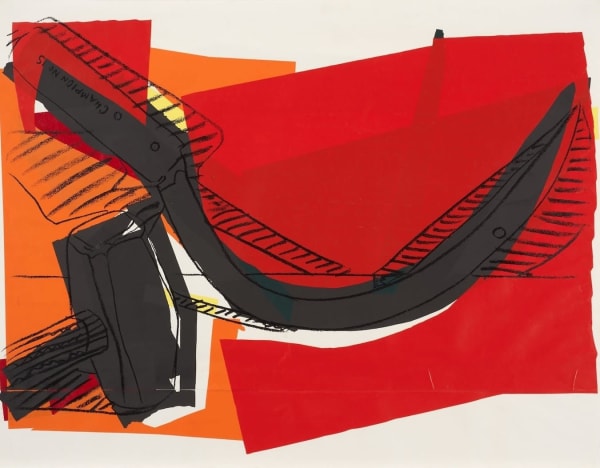
Andy Warhol
Signed and numbered in pencil on lower left.
81.3 x 101.6 cm
Warhol’s Hammer And Sickle (F & S. Ii 162) is one of four screenprints in Andy Warhol’s provocative 1977 Hammer and Sickle portfolio. Inspired by a 1976 trip to Italy, where he encountered ubiquitous graffiti featuring the communist symbol, Warhol was captivated not by its political doctrine, but by its cultural saturation and visual impact. Amid Cold War tensions, the hammer and sickle had become more than a political emblem—it was a symbol charged with fear, defiance, and ideology. Warhol approached it with characteristic detachment, fascinated by its repetition, transformation, and evolving meaning.
Rather than relying on preexisting imagery, Warhol sought authenticity in his process. Upon returning to New York, he tasked his assistant, Ronnie Cutrone, with finding visual references for the project. Disappointed by lifeless reproductions in books and flags, Warhol opted for a more tangible approach: Cutrone purchased a real hammer and sickle from a hardware store and photographed them in various arrangements. These photographs became the compositional foundation for the series, offering Warhol the opportunity to reinterpret the symbol as a still life rather than a political statement.
In Hammer And Sickle (F & S. Ii 162), Warhol strips down the symbol’s intensity by rendering the tools in white, their contours sketched in black. The shadows—cast in deep red-purple and edged with rough black lines—add dimension and visual tension. Bright blocks of red form the background, making this the most luminous print in the portfolio. Notably, it is the only piece in the series that omits heavy black elements and depicts the hammer and sickle in white, a striking visual departure from the darker tones of its counterparts.
This tonal contrast lends Hammer And Sickle (F & S. Ii 162) a sense of ideological duality. While other prints in the series conjure associations with violence, revolution, and bloodshed, this piece leans into a more idealistic reading. The white tools may symbolize the purity of communist aspirations, while the stark, looming shadows speak to the darker realities that often accompanied them. Through this juxtaposition, Warhol subtly invites viewers to reflect on the gap between utopian theory and political execution.
When the portfolio debuted at the Castelli Gallery under the ironic title *Still Lifes*, Warhol encouraged viewers to reconsider the symbol’s weight. By reframing these charged icons as ordinary objects, he blurred the line between propaganda and art, ideology and aesthetics. His approach exemplifies the essence of Pop Art: recontextualizing familiar imagery to spark new conversations about meaning, perception, and power.
With Hammer And Sickle (F & S. Ii 162), Warhol showcases his uncanny ability to deconstruct potent cultural symbols and reassemble them within a visual and conceptual framework. The result is a work that resonates far beyond its immediate visual impact—one that continues to challenge and engage viewers decades after its creation.
For more information on Warhol’s Hammer And Sickle (F & S. Ii 162) or to buy Hammer And Sickle (F & S. Ii 162), contact our galleries using the form below.
Join our mailing list
* denotes required fields
We will process the personal data you have supplied in accordance with our privacy policy (available on request). You can unsubscribe or change your preferences at any time by clicking the link in our emails.
This website uses cookies
This site uses cookies to help make it more useful to you. Find out more about cookies.



